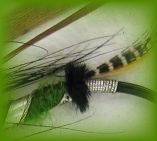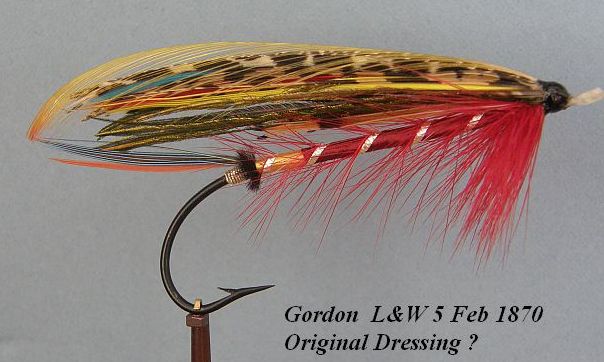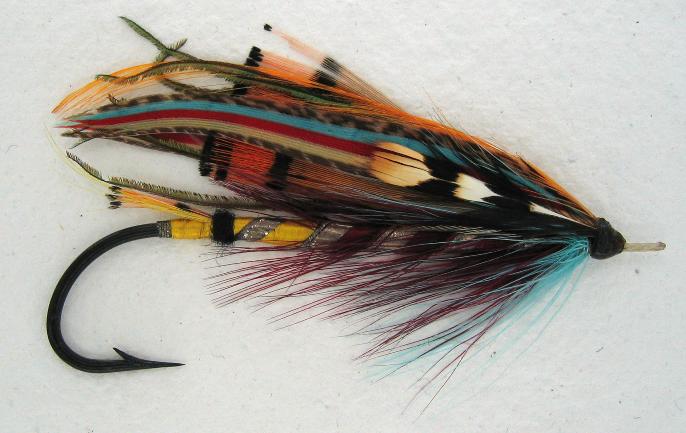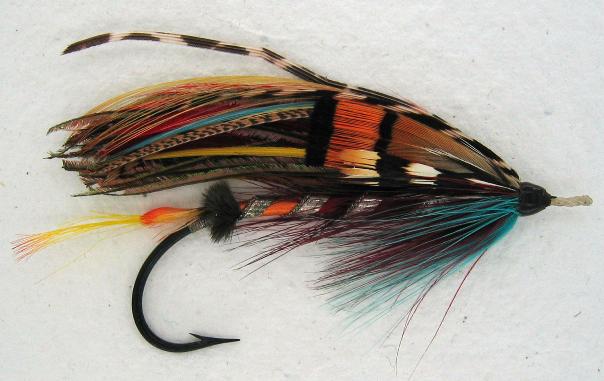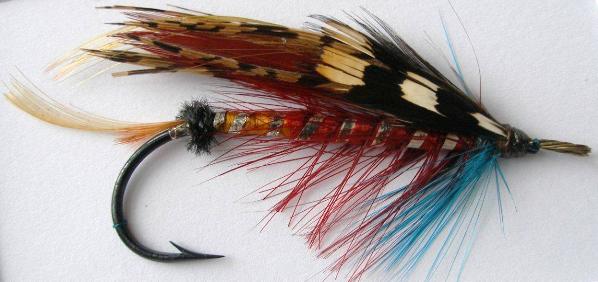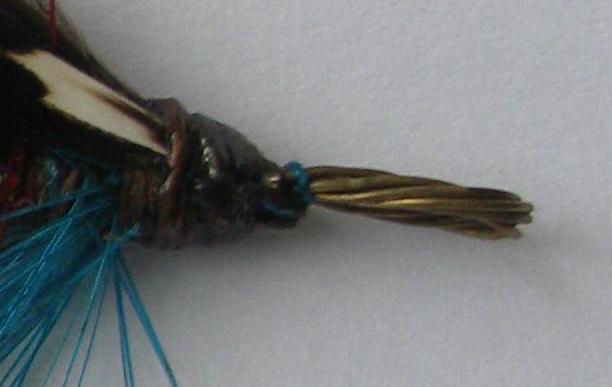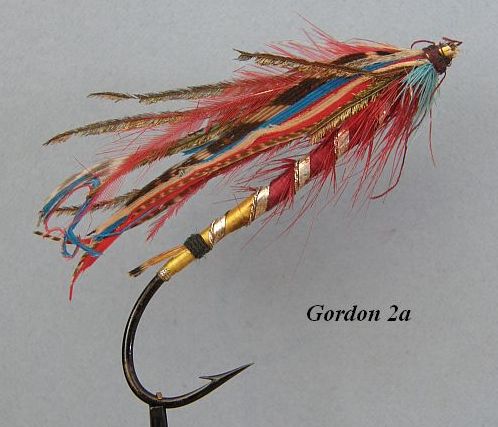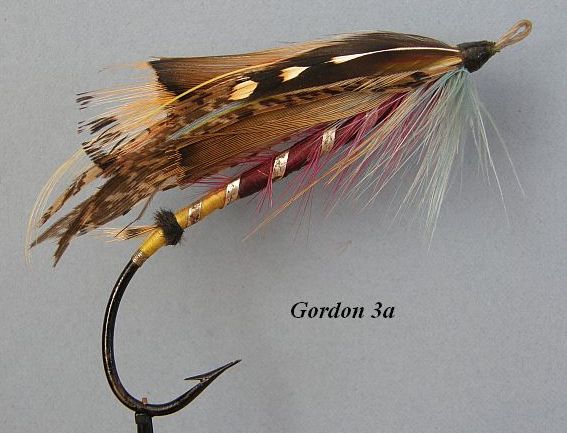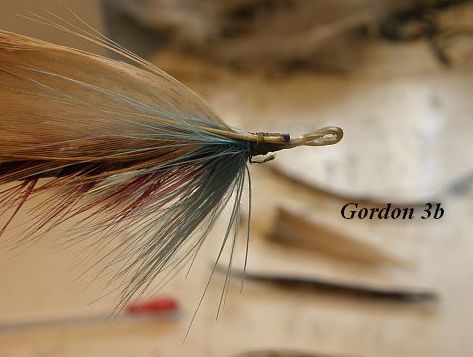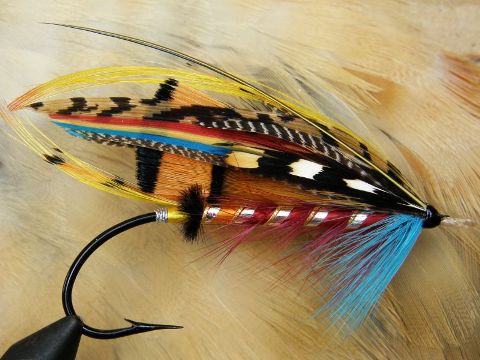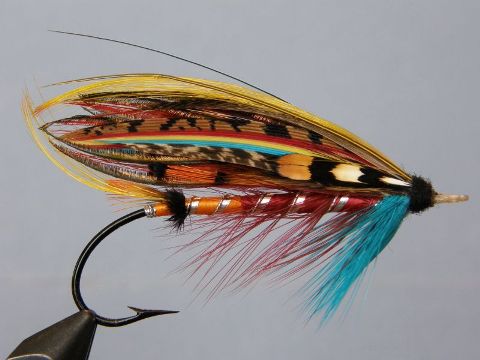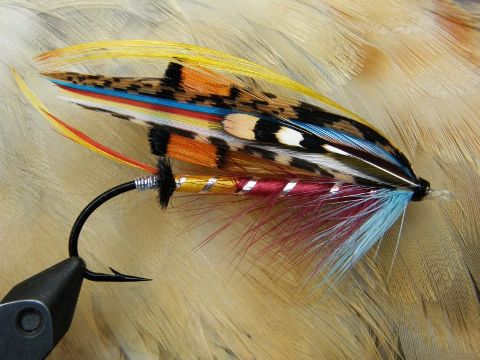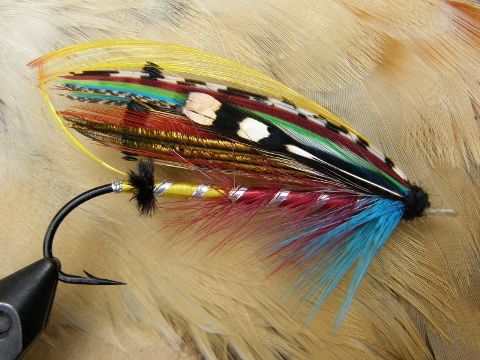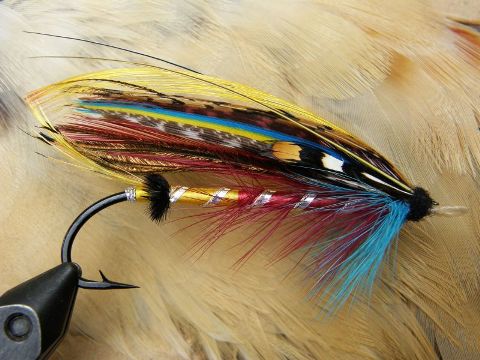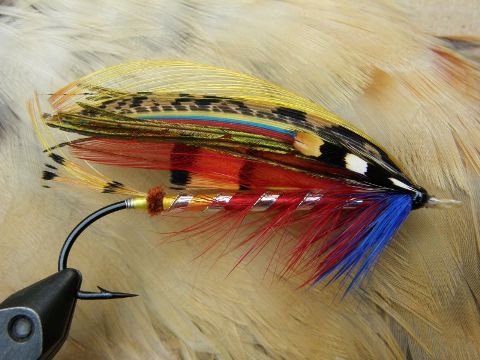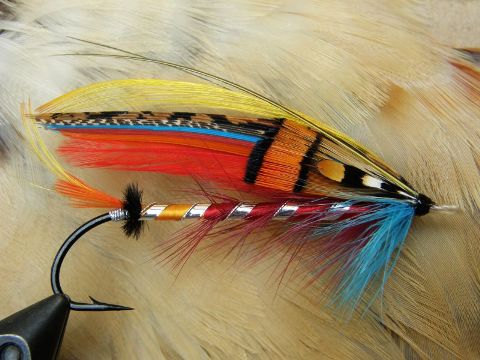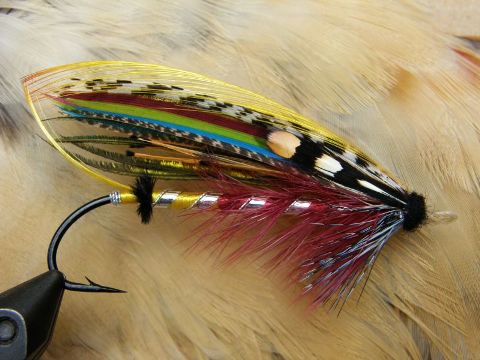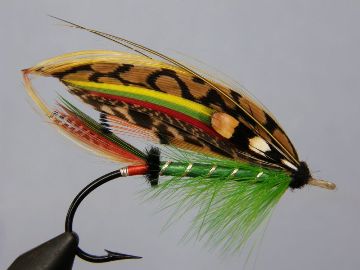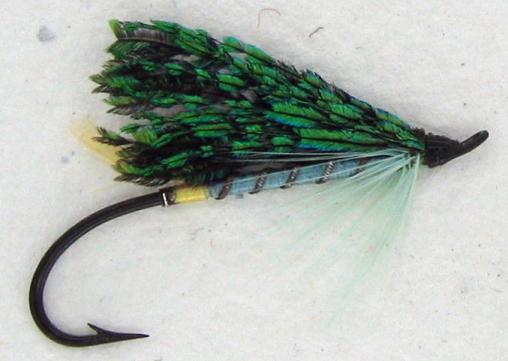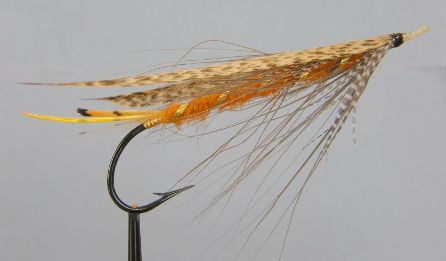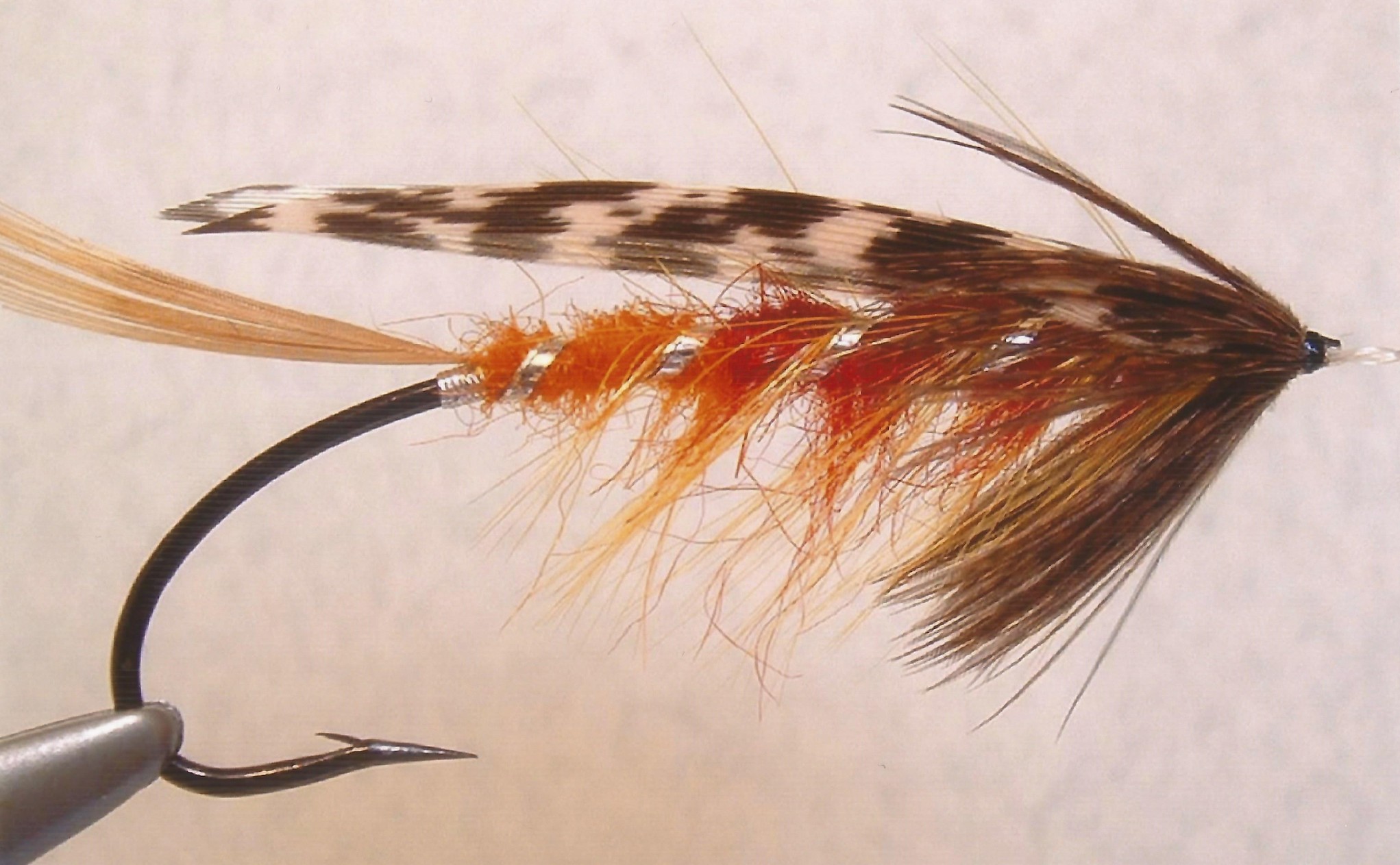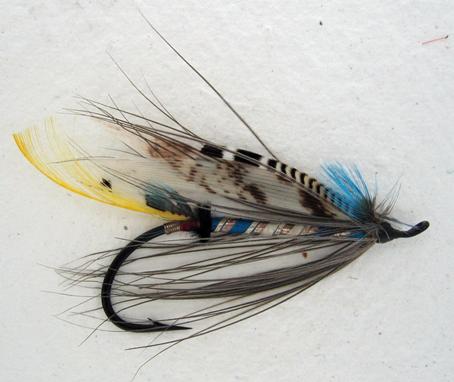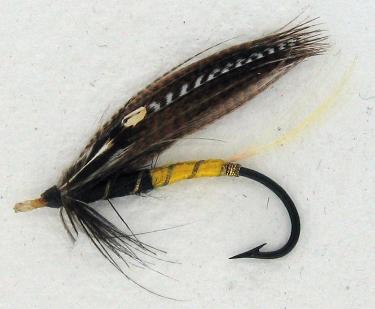 |
 |
|
On this page Gordon, Gordon Ranger, Green Parrot, Green Peacock, Grey Heron, Inchgarth, Irvine, Jeannie, Jock o' Dee. Please scroll down. Gordon On my first day I made but a poor hand of it, as I used Mr. Brown’s flies, but on the second, after an evening’s chat and a comparison of notes with my two friends who were located there with me, my bag told a different tale. For this good sport I am purely indebted to Mr. Cosmo Gordon, a gentleman whose exploits with the rod must deservedly class him amongst the foremost rank of salmon fishers. The dull brown wings, and the fluffy looking eagle bodied flies, were soon transferred to that omnium gatherum pocket of my book where all such waste tackle goes to, in case they might be useful upon an occasion, and in their place I used flies twice their size, dressed upon Phillips’ hooks and of gaudier colours. These were purely the invention of Mr. Gordon and tied by us both.” Tail: Red & Blue Macaw A feather from under the wing of an oystercatcher, dyed Yellow, was a useful addition to the wing for evening fishing.
A rather old and tatty Gordon
The same fly after a trip overseas to Bob's Hospital
Another patient
After Surgery
Now this is an interesting one - lets take a look at that wing...
Interesting - tied on the sides..
The wing components laid out in order
Reconstructed WM Tag: Silver tinsel and yellow floss. Tail: A topping and fibres of golden pheasant tippet. Butt: Black ostrich herl. Body: One turn orange, three turns claret floss. Rib: Silver tinsel and gold flatworm. Hackle: Claret. Shoulder: Light blue cock hackle. Wing: Under wing, two large golden pheasant tippets on either side, fibres of teal and bustard, golden pheasant tail, blue, red, and yellow swan. Topping over all. Cheeks: Jungle cock. Horns: Blue macaw. Head: Black.
Walbran Tag: Silver thread and medium orange floss. Tail: A topping and Indian crow. Butt: Black ostrich. Body: Four turns medium orange floss, the remained medium shade of claret floss. Ribbed with silver tinsel and silver twist. Hackle: Claret to match body (from orange floss). Shoulder: Greenish blue hackle. Wing: Under, two tippets tied back to back, extending to butt, with a red rump feather projecting about half an inch; upper wing, bustard, pheasant’s tail, peacocks wing, dark brown mallard, blue, red, and yellow swan, with a considerable amount of bronze peacock’s herl, and a topping over all; sides, jungle, two spots. Horns: Blue macaw. Head: Black wool. This is an exceedingly handsome and showy fly; Mr Murdoch states that it is a great favourite on the Dee, and is responsible for the death of many a fine salmon. William Murdoch, Fishing Gazette 1886 Tag: Silver thread and orange (medium) floss. Tail: A topping and Indian crow. Butt: Black ostrich Body: Four turns orange (medium) floss, the remainder claret colour floss, medium shade. Ribbed: Silver tinsel and silver twist. Hackle: Claret, to match body, from orange floss Throat: Greenish-blue hackle. Wing: Two tippets back to back extending to butt, with a rump feather (red) projecting about ½in.; bustard, pheasants tail, peacock wing, dark brown mallard, blue, red and yellow swan, and a considerable quantity of bronze herl; topping all over. Sides: Jungle (two spots). Horns: Blue macaw. Head: Black wool. The best fly of the fancy order put upon the river Dee, the Gordon, dressed sparely, and on slender wire, cuts the swiftly flowing water most beautifully, and plays immense havoc amongst the fish. In spring and autumn no fly approaches it for general usefulness, or is half so much used. A veteran and a favourite, the Gordon has never lost an inch of ground. The best fly for coloured or high running waters, it competes with the Grey Eagle for the first place as an evening lure; in short, it is better known on the
Grimble, Shooting & Salmon Fishing – 1892 Tag: Silver twist. Tail: Topping and red ibis. Butt: Black. Body: Two turns of orange yellow floss silk and the rest rich claret floss, silver tinsel, and, if the fly be large, then silver twist by the side of it. Hackle: Claret from commencement of claret floss, and light blue at shoulder, or in a small fly jay hackle will do. Wing: Two feathers of gold pheasant ruff, reaching to black butt, over these a mixture of gold pheasant tail, peacock, white, yellow, red, and blue fibres of dyed swan, a long topping over all, jungle cock cheeks and a black head. If the fly be dressed large, one or two sword feathers of the gold pheasant should be added over the gold pheasant ruff feathers.
Grimbles version tied by Bob Fransden Kelson – The Salmon Fly, 1885 William Browns dressing Tag: Silver twist and yellow silk. Tail: A topping. Butt: Black herl. Body: One third yellow silk, and claret silk. Ribs: Silver lace and silver tinsel (flat). Hackle: Claret hackle, from yellow silk. Throat: Blue hackle. Wings: One tippet backed with a sword feather of golden pheasant; peacock herl, bustard, swan dyed light blue, light green, and red-claret; Sides: Jungle. Head: Black wool.
William Tail: A topping and tippet strands. Butt: Black herl. Body: One third dark yellow silk, and claret silk. Ribs: Silver lace and silver tinsel (flat). Hackle: Claret hackle, from dark yellow silk. Throat: Blue hackle. Wings: Two light red-claret hackles (back to back) veiled with peacock herl, light (grey) mottled turkey, golden pheasant tail, bustard, swan dyed yellow and blue; light mottled turkey dyed claret, and a topping. Sides: Jungle. Horns: Blue macaw. Head: Black wool.
Kelson, includes the following notes about the Gordon in The Salmon Fly: “The taste for varying this pattern has doubtless arisen from the fact that there are fishermen who, like myself, are not always satisfied with any of the standards. We tone them down or brighten them up as circumstances in fishing direct. “But,” writes a friend who knew the inventor, “the swift impress that a truthfully dressed ‘Gordon’ makes on the mind of a Dee Fisherman is one it needs no special studio training to enjoy.” As most people know, this fly is simply “lionised” on the Mr. Cosmo Gordon, the inventor, used to be particular about the colour and amount of hackle frequently using two feathers together. He also had Jay at the throat instead of the dyed hackle as used now. He, moreover, had the tippets in strands, and objected to the whole feather in the wings. “At one time,” says William Brown, “Jay was employed as a throat hackle.” Mr. Gordon was not only a good Salmon-angler, but also a good judge of flies, an experience not picked up at home, by any means, for the Dee was, and is still, early in the season, little more than a four-fly river in his day. It is reported that he fished with other people’s flies; but I, who knew he bought them, stoutly maintain that they were his own. Of the many doubtful but conscientious representations of the “Gordon” I have decided to give the two following dressings as practiced at present in
Kelson also mentions the Gordon in Tips published in 1901 : On the
Kelson – Land & Water Flies c 1885. “By the kind assistance recently give me by Mr. Murdoch I find that Brown, of Aberdeen, keeping an establishment in George Street, always dresses “The Gordon” with Indian Crow in the tail*, and he assures me that this was the original way of making it. The letter speaks in high terms of all Brown’s Maxwell – Fishing at Home and Abroad – 1913 Tag: Silver wire and lemon floss, Tail: Golden pheasant topping with fibres of tippet. Butt: Bronze chenille. Body: One third golden floss, remainder crimson floss. Rib: Broad silver tinsel and silver twist. Hackle: Crimson hackle over crimson floss, sky blue hackle at shoulder. Wing: Two short tippet feathers, two crimson cock hackles, a few fibres of crimson, blue and yellow dyed swan, bustard and peacock herl, jungle fowl at cheek, topping over all. In tying this or any other salmon fly, tackle makers often make the mistake of putting too much feather in the wing. It is far better to fish with a fly rather bare and thin than one overdressed. “The Gordon” originally came from Deeside; but if I was limited to the use of one pattern in any river, this is the one I would choose for it is the only fly for which, when harling in the Tay with three rods astern, each with a different fly, I have fancied that salmon show a preference. It is an excellent fly on any size of hook and in all fishable conditions of water or weather.
Tag: Silver tinsel. Tail: A topping and Indian crow. Butt: Black herl. Body: First quarter, light orange floss; remainder, ruby red floss. Ribs: Flat silver tinsel and twist. Hackle: A claret hackle. Throat: A light blue hackle. Wings: Mixed - a pair of bright red hackles (back to back) or of golden pheasant sword feathers (in larger sizes); strands of orange, scarlet, and blue swan, golden pheasant tail, and bustard. Cheeks: Tippets (small), and jungle cock over; a topping over all. Horns: Blue and yellow macaw. Hook: 1¼ to 3 inches.
Hardy – Salmon Fishing, 1907 Tag: Silver tinsel and yellow floss. Tail: A topping. Butt: Black herl. Body: Half yellow floss, then claret floss. Ribs: Silver lace and silver tinsel (flat). Hackle: Claret hackle. Throat: Blue hackle. Wings: One tippet backed with a sword feather of golden pheasant; peacock herl, bustard, swan dyed light blue, light green, and red-claret; Sides: Jungle cock. Head: Black.
Gordon Ranger Vintage Green Parrot
William Murdoch Tag: Silver twist and dark orange floss. Tail: A topping, teal, and red and green parrot. Butt: Black ostrich. Body: Peas green floss. Ribbed: Oval tinsel. Hackle: Grass green, from first turn of tinsel. Wing: Fibres of tippet; broadish strip of peacock wing; bustard, pheasant tail, teal, red-green and yellow swan, with a topping over all. Cheeks: Jungle (two spots). Horns: Blue macaw. Head: Black wool. The “Green Parrot,” is a great killer on the Ythan, and a very good fly in almost any river in the North. The above dressing of the Green Parrot is given by Mr. Wm. Garden, gun and fishing tackle maker, Hardy – Salmon Fishing, 1907 Tag: Silver tinsel; yellow floss. Tail: Topping and tippet. Body: Violet floss. Ribs: Silver tinsel. Throat: Parrot. Wings: Golden pheasant tippet and yellow rump feather; parrot; guinea fowl; ibis; yellow macaw; mallard. Cheeks: Indian crow. Head: Black.
Green Peacock
Vintage Walbran, British Angler, 1889 Tag: Silver twist and light yellow floss Tail: A topping and chatterer. Body: Pale blue floss. Ribbed: Oval silver tinsel Hackle: Greenish blue, from half-way down body. Wings: Herl of peacock’s spear feather. Head: Black. To be dressed only in small sizes. Mr. Murdoch also sends me a small Dee pattern invented by himself that I like the look of immensely, it is in appearance like a glorified “Alexandria,” and I am certain, under the conditions named, by Mr. M., it will kill its share of fish, - he says “This fly cannot be touched on the Dee in summer on bright days, when the water is very clear; it has a capital reputation on all bright bottomed rivers in a clear water.”
Green Peacock Tag: Canary floss and silver thread. Tail: A topping or two. Body: Pale blue floss. Ribbed: Silver flat-worm. Hackle: Greenish blue - at shoulder only. Wings: Green peacock herl. Head: Black wool. Sizes the most useful: Nos. 6, 7, 8, 9, Limerick Bend hooks (Bartleet and Sons’ scale). Green Peacock (Variety) Tag: Gold thread. Tail: A topping or two. Butt: Green herl Body: Bright green mohair. Ribbed: Gold flat-worm. Hackle: Green to match mohair - up body. Wings: Green peacock herl. Head: Black wool. Sizes the most useful: Nos. 5, 6, 7, 8, Limerick Bend hooks (Bartleet and Sons’ scale).
Green Peacock. - Specially good in velar sharp water, but often goes down well when the water is a trifle brown, purely a daytime fly and of little use save when the sun is intensely bright. Grey Heron WM Tag: Gold tinsel. Tail: A topping and golden pheasant tippet (small). Body: Rib: Gold tinsel. Hackle: Grey heron. Shoulder: Teal Wing: Mottled turkey, brownish tinge. Head: Black. Grimble, Shooting & Salmon Fishing – 1892 Tag: Two turns of gold tinsel. Body: Barely one-third orange floss and rest black floss, gold tinsel put on very wide, and between the turns a single strand of fine silver twist; in a large fly two strands can be used, each equidistant from the other. Hackles: Grey Heron from half way up, and teal at shoulder. Wing: Mallard In spite of sombre look and meagre appearance, caused by the absence of tail and the shortness of wing, this fly is a very killing one wherever quiet flies and sparely-dressed hooks are in favour, and we have rarely failed to score when giving it a trial. Pryce-Tannatt - How to Dress Salmon Flies, 1914 Body: First third, lemon Berlin wool; remainder, black Berlin wool. Ribs: Flat silver tinsel, and oval silver and gold tinsels. Hackle: A grey heron hackle from one end of the body tied in at the point (or, almost better, a hackle from the rump of a blue game hen). Throat: Speckled Gallina. Wings: Brown mallard strips (short). Hook: 1½ to 2½ inches. Grey Heron, Model WM – Tag: Gold thread and topping-coloured floss silk Tail: Fibres of tippet. Body: Orange-coloured pig’s wool or mohair (the former by preference), well picked out. Ribbed: Broad flat gold tinsel and gold twist, five turns. Hackle: Long grey heron, wound openly round body. Shoulder: Teal. Wings: Either cream-coloured turkey strips, or distinctly barred black and white turkey strips. Head: Black. Mr. George Smith, Tackle Merchant, Ballater, has a splendid stock of these patterns, most of which are proved killer on all reaches above, and a good many reached below, that place.
Inchgarth
A nice Inchgarth by Philip Glendinning WM , Tag: Silver thread Tail: Saddle feather of golden pheasant. Body: Three turns of golden orange and four turns fiery red mohair. Ribbed: Silver tinsel and gold twist. Hackle: Golden yellow cock hackle from the first turn of yellow; grouse hackle at shoulder. Wings: Two strips of the black and tan feather from a peacock’s wing. The Inchgarth, which, though little known to anglers, is a very deadly fly both on Dee and Don, is one of the admirable patterns dressed by William Milne, Fishing Tackle Maker, Stirling Street, Aberdeen.
Irvine
This vintage fly is named after Sandy Irvine of Drum Castle the inventor of the Drum series of flies, it's a fly that's been in my collection for ages that I failed to identify, it was recently identified by Philip Glendinning, the dressing is as follows (note the vintage example above has a floss rather than seal's fur body specified in the dressing):
This example has been tied by Australian tyer Bob Frandsen Tag: Oval silver, crimson floss Tail: Topping, summer duck and chatterer. Butt: Black ostrich. Body: ⅓ blue seal, ⅓ white seal and ⅓ blue seal. Rib: Flat and oval silver. Throat: Long fibred grey heron. Wing: Grey turkey. Sides: Barred wood duck. Cheeks: Blue chatterer. Jeannie
Vintage WM Tag: Gold twist. Tail: Small topping. Body: Black and orange silk floss, two-thirds black, one third orange, the orange nearest to tag. Ribbing: Gold flat worm. Hackle: Black only at shoulder. Wings: Double strips of very dark mallard – i.e., four pieces, two at each side, the one above the other. With or without a topping over wing. Cheeks: Jungle fowl. Head: Black. Double Limericks – Sizes, No. 4, 5, and 6. Is a popular salmon fly in the early summer. Hitherto, it has been used most generally about Aboyne, Ballater, and Braemar. It is nothing more nor less than an inexpensive substitute for a Jock Scott. We have not yet used it for grilse, but reckon it would take fairly well. It may be regarded as a good general fly, the size to be used being regulated by the state of the water. WM states that “We have failed to trace the originator” of this fly. [Kelson attributes the pattern to William Brown - although I feel that when Kelson attributes a fly, he is mearly saying that that is where he got his pattern from!]
Kelson – The Salmon Fly, 1885 Tag: Silver twist. Tail: A topping. Body: One-third yellow silk, followed by black silk. Ribs: Silver tinsel. Throat: A natural black hackle. Wings: Mallard. Sides: Jungle. A great favourite in summer on the Pryce-Tannatt - How to Dress Salmon Flies, 1914 Tag: Silver tinsel Tail: A topping. Body: First third lemon floss, remainder black floss. Ribs: Oval silver tinsel Throat: A (natural) black hackle. Wings: Brown mallard strips (set upright) Sides: Jungle Cock. Hook: ¾ to 1⅛ inches. Hardy – Salmon Fishing, 1907 Tag: Silver tinsel. Tail: A topping. Body: One-third yellow floss, followed by black floss. Ribs: Silver tinsel. Throat: Black hackle. Wings: Mallard. Sides: Jungle cock. Head: Black. “Jock Scott” – Greased Line Fishing for Salmon, 1936 Tag: Silver wire. Tail: G.P. crest. Body: Two turns of yellow floss, remainder black. Ribs: Silver Hackle: Black Wing: Mallard Cheeks: Jungle cock. Jock o’ Pryce-Tannatt - How to Dress Salmon Flies, 1914 Tag: Silver tinsel. Tail: A topping and Indian crow. Body: Two-fifths, lemon floss; remainder, black floss. Ribs: Flat silver tinsel and twist. Hackle: A grey heron’s hackle from third turn of tinsel. Throat: Widgeon. Wings: A pair of cinnamon turkey tail strips (set flat). Hook: 1½ to 3 inches.
|
